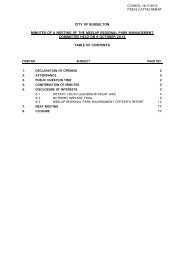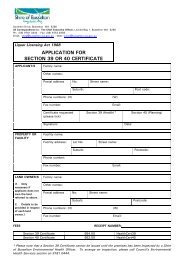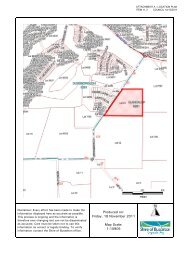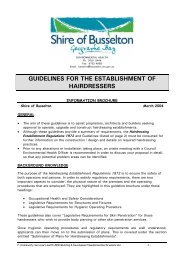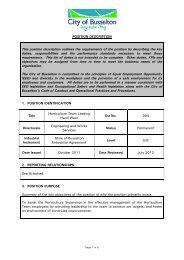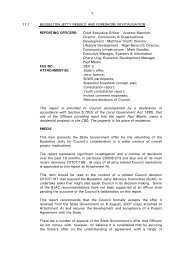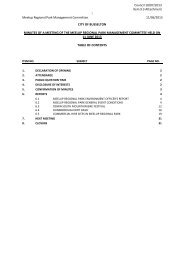Draft Guidelines for the Reuse of Greywater in Western Australia
Draft Guidelines for the Reuse of Greywater in Western Australia
Draft Guidelines for the Reuse of Greywater in Western Australia
You also want an ePaper? Increase the reach of your titles
YUMPU automatically turns print PDFs into web optimized ePapers that Google loves.
The dos<br />
DRAFT<br />
●<br />
●<br />
●<br />
Select garden friendly detergents. Only biodegradable products and products with low<br />
phosphorus, sodium, boron, chlor<strong>in</strong>e and borax should be used. Bleaches and fabric<br />
s<strong>of</strong>teners should be used spar<strong>in</strong>gly.<br />
Apply greywater <strong>in</strong> several locations ra<strong>the</strong>r than one s<strong>in</strong>gle po<strong>in</strong>t, so that pool<strong>in</strong>g <strong>of</strong><br />
greywater does not occur.<br />
Apply greywater to areas that are not readily accessible to children and household<br />
pets.<br />
The don’ts<br />
●<br />
●<br />
●<br />
●<br />
●<br />
●<br />
Don’t use greywater from <strong>the</strong> wash<strong>in</strong>g <strong>of</strong> nappies and soiled cloth<strong>in</strong>g.<br />
Don’t use greywater when a household resident has an <strong>in</strong>fectious disease such as<br />
diarrhoea, <strong>in</strong>fectious hepatitis, <strong>in</strong>test<strong>in</strong>al parasites, etc.<br />
Don’t discharge greywater on edible plants or where fruit fallen to <strong>the</strong> ground is eaten.<br />
Don’t store greywater. Stored greywater will turn septic giv<strong>in</strong>g rise to <strong>of</strong>fensive odours<br />
and provide conditions <strong>for</strong> micro-organisms to multiply.<br />
Don’t let your greywater go beyond your property and cause a nuisance <strong>for</strong> your<br />
neighbours.<br />
Don’t over water. Over application <strong>of</strong> greywater may clog <strong>the</strong> soil caus<strong>in</strong>g <strong>the</strong> pool<strong>in</strong>g<br />
<strong>of</strong> greywater, which can result <strong>in</strong> <strong>the</strong> development <strong>of</strong> unsightly areas <strong>of</strong> grey/green<br />
slime. This slime is caused by <strong>the</strong> presence <strong>of</strong> soaps, shampoos, detergents and<br />
grease <strong>in</strong> greywater. The accumulation <strong>of</strong> slime can cause odours, attract <strong>in</strong>sects and<br />
cause environmental damage.<br />
Note: Plants <strong>of</strong> <strong>the</strong> Proteaceae family evolved <strong>in</strong> low phosphorus soils and are <strong>the</strong>re<strong>for</strong>e<br />
susceptible to excess phosphates. These plants are not really suited to greywater reuse<br />
and <strong>in</strong>clude grevillea, hakea, banksia and silky oak. Shade lov<strong>in</strong>g and acid lov<strong>in</strong>g plants<br />
do not like <strong>the</strong> alkal<strong>in</strong>ity <strong>of</strong> greywater. These <strong>in</strong>clude azaleas, camellias, gardenias,<br />
begonias, and ferns.<br />
Where can I f<strong>in</strong>d more <strong>in</strong><strong>for</strong>mation?<br />
Contact <strong>the</strong> Environmental Health Officer at your Local Government <strong>of</strong>fice or <strong>the</strong><br />
Wastewater Management Section at <strong>the</strong> Department <strong>of</strong> Health on phone: (08) 9388 4932.<br />
30 <strong>Draft</strong> <strong>Guidel<strong>in</strong>es</strong> <strong>for</strong> <strong>the</strong> <strong>Reuse</strong> <strong>of</strong> <strong>Greywater</strong> <strong>in</strong> <strong>Western</strong> <strong>Australia</strong>




